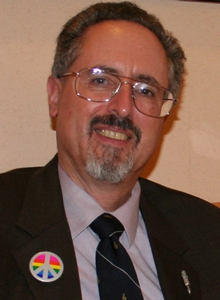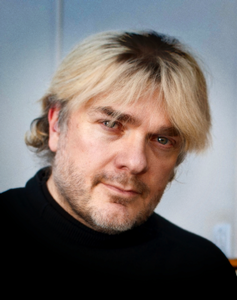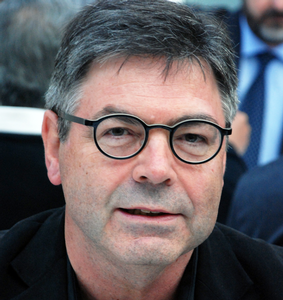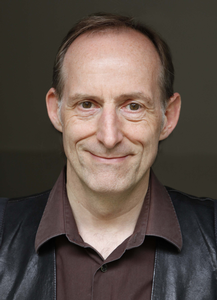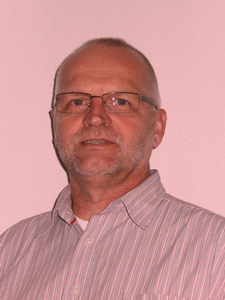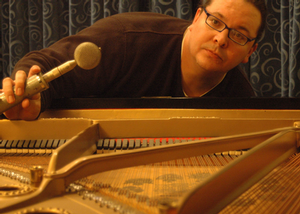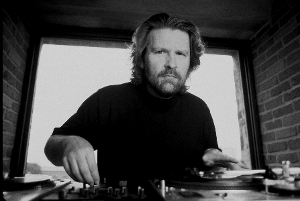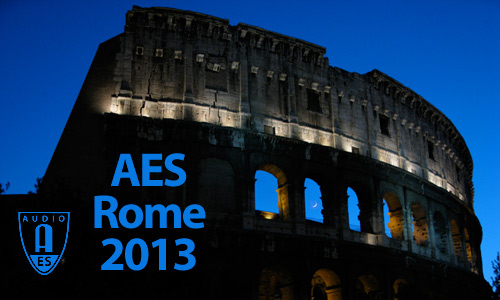
AES Rome 2013
Tutorial Details
Saturday, May 4, 11:00 — 12:30 (Sala Alighieri)
T1 - Microphone Technology
Presenter:Ron Streicher, Pacific Audio-Visual Enterprises - Pasadena, CA, USA
Abstract:
How do microphones work? What differentiates one operating type of transducer from another? How and why do they sound different? What are polar patterns, and how do they affect the way a microphone responds to sound? What is “proximity effect” and why do some mics exhibit more of it than others? What’s the truth about capsule size — does it really matter? These are just a few of the topics covered in this in-depth tutorial on Microphone Technology.
Saturday, May 4, 16:30 — 18:30 (Auditorium Loyola)
T2 - Are We There Yet? The Ultimate Ultra-Portable Production/Recording Studio. From Idea to Final Master: How to Write, Sequence, Produce Your Music, and Control Your Studio Using only Your iPad
Presenter:Andrea Pejrolo
Abstract:
In this highly interactive and hands-on presentation you will learn the tools, techniques, tips, and tricks required to write, produce, and mix a song using only your iPad.
Through practical examples and scenarios you will learn how to:
• Pick the best software for sequencing, producing, and mixing your music
• Pick the best iPad-compatible hardware tools (microphones, audio interface, MIDI interfaces, controller, etc.)
• Setup your mobile production studio
• Sketch your musical ideas
• Use your iPad as a creative inspirational tool for music composition and sound design
• Sequence and arrange your music ideas on your iPad
• Add real instruments and vocals
• Do a final professional mix
• Master your final mix
In addition, through practical examples and scenarios, you will learn: how to set up your studio in order to use your iOS device as a controller; configuration of iOS device for Logic Pro, Pro Tools, Digital Performer, Live, and Cubase/Nuendo; wireless (MIDI over WI-FI) and wired MIDI connection; proprietary versus open source (OSC, etc.) options; designing your own graphic interface and controllers; ergonomic aspects of using your iOS device in the studio.
Who should attend? Anyone who wants to create some music with their iPads, from beginners to advanced, Musicians, producers, recording engineers, home studio owners from intermediate to advanced.
Saturday, May 4, 16:30 — 18:30 (Sala Alighieri)
T3 - Music Production for Film
Presenter:Simon Franglen, Class1 Media - Los Angeles; London
Abstract:
Music production is the last piece of the production puzzle to be undertaken in a film production. It occurs after the film is edited and just prior to sound mixing. The composers have developed new tools to prepare the music including temp synth scores and other techniques. Simon Franglin is a Golden Globe nominee and has worked on Avatar, Titanic, and Skyfall 007, among many others.
Saturday, May 4, 17:00 — 18:30 (Sala Foscolo)
T4 - Understanding Microphone Specifications
Presenter:Eddy B. Brixen, EBB-consult - Smorum, Denmark
Abstract:
There are lots and lots of microphones available to the audio engineer. The final choice is often made on the basis of experience or perhaps just habits. (Sometimes the mic is chosen because of the looks … .) Nevertheless, there is good information to be found in the microphone specifications. This tutorial will present the most important microphone specs and provide the attendee with up-to-date information on how these specs are obtained and understood. It also takes a critical look on how specs are presented to the user, what to look for and what to expect.
This tutorial is a follow up on the project X85, which has been taking place in the AES standards committee (SC 04-04).
Sunday, May 5, 10:00 — 11:00 (Sala Manzoni)
T5 - 3-D Audio—Produce the New Dimension
Presenter:Tom Ammermann, New Audio Technology GmbH - Hamburg, Germany
Abstract:
This workshop will have two parts. The first will be a presentation where new experiences and different ways to handle the different approaches like film, music, and radio plays will be shown. Complete sessions will be opened and production experiences, editing, as well as workflows and possibilities to delivery 3-D/spatial content into the common market will be shown and discussed.
The second part of this workshopwill be a Q & A session while a group of max. 10 participants can listen and work with 3-D content via a sophisticated 3D speaker virtualization on headphones.
Sunday, May 5, 11:00 — 13:00 (Auditorium Loyola)
T6 - Drum Programming
Presenter:Justin Paterson, London College of Music, University of West London - London, UK
Abstract:
Drum programming has been evolving at the heart of many studio productions for some 30 years. Over this period, technological opportunities for enhanced creativity have multiplied in numerous directions. This tutorial will demonstrate a number of these directions as they are often implemented in contemporary professional practice, showing contrasting techniques used in the creation of both human emulation and the unashamedly synthetic. Alongside this, many of the studio production techniques often used to enhance such work will be discussed, ranging from dynamic processing to intricate automation.
The session will include numerous live demonstrations covering a range of approaches. Although introducing all key concepts from scratch, its range and hybridization should provide inspiration even for experienced practitioners.
Sunday, May 5, 11:30 — 13:00 (Sala Manzoni)
T7 - Acoustic Enhancement Systems—The Basics
Presenter:Ben Kok, SCENA acoustic consultants - Uden, The Netherlands
Abstract:
In the last decades multiple systems for electronic acoustic enhancement have been introduced. Some have disappeared over time, but others appear to be settled firmly. The claim for these systems is that the acoustics of a venue can be changed at the press of a button, at cost significantly lower than variable acoustics by structural means. Also, in situations where the natural acoustics did not work out properly, these systems are used to correct the flaws, again at lower costs than the structural alternatives. The question, of course, is do these systems really work and if so, what are the differences between these systems? And what would be the structural alternatives?
This tutorial will identify what acoustic properties can or should be influenced by an acoustic enhancement system. In relation to this, working principles and philosophies of some of the most popular systems are analyzed and similarities and differences are identified and related to specific acoustic situations.
Sunday, May 5, 12:00 — 13:00 (Sala Foscolo)
T8 - Perceptual Testing of Speech in Modern Audio Products
Presenter:Dan Foley, Audio Precision
Abstract:
We are witnessing a convergence of audio technologies in modern compact consumer products, with small computing devices processing voice and general audio through a range of options that include analog, electro-acoustic, Bluetooth, HDMI, and more. Whereas in the past sine and noise-based test signals have been used to verify performance, these new devices require both a mixture of connectivity options and the ability to assess the perceptual needs of voice communication.
Tests such as Perceptual Speech Quality (PESQ) and Perceptual Listening Quality (POLQA) are now being used to fully assess device performance where codecs and other non-linear processing is used. This presentation will focus on how these perceptual methods work and when to use them in conjunction with, or in lieu of, classic audio test methods and techniques.
Sunday, May 5, 14:45 — 16:15 (Auditorium Loyola)
T9 - Electric Guitar—What a Recordist Ought to Know
Presenter:Alex Case, University of Massachusetts—Lowell - Lowell, MA, USA
Abstract:
Musicians obsess about every detail of their instrument. Engineers do the same with every detail of their studio. This tutorial merges those obsessions, so that a recording engineer can be more fully informed about the key drivers of tone for the electric guitar. Know the instrument first and let that drive your decisions for recording and mixing the instrument.
Monday, May 6, 09:00 — 10:30 (Auditorium Loyola)
T10 - Creative Distortion—You Are in the Over-Driver's Seat
Presenter:Alex Case, University of Massachusetts—Lowell - Lowell, MA, USA
Abstract:
Distortion, strategically applied to elements of your mix, is a source of energy that lifts tracks up out of a crowded arrangement and adds excitement to the performance. Accidental distortion, on the other hand, is a certain sign that the production is unprofessional, dragging down its chance for success. Amps, stomp boxes, tubes, transformers, tape machines, the plug-ins that emulate them, and the plug-ins that create wholly new forms of distortion all offer a rich palette of distortion colors. Mix engineers must know how to choose among them, and how to tailor them to the music. This tutorial takes a close look at distortion, detailing the technical goings-on when things break-up, and defining the production potential of this, the caffeine of effects.
Monday, May 6, 11:30 — 13:00 (Sala Foscolo)
T11 - Optimizing and Measuring the Speech Intelligibility of Sound Systems
Presenters:Ben Kok, SCENA acoustic consultants - Uden, The Netherlands
Peter Mapp, Peter Mapp Associates - Colchester, Essex, UK
Abstract:
Intelligibility is the most important parameter of any sound system—albeit a high-quality, theater sound reinforcement system, a church, or an emergency PA system operating deep underground in a road tunnel or an information system at an airport or rail station. The tutorial will discuss how to design intelligible sound systems for both sound reinforcement and emergency systems use. It will show how reverberation and noise and other acoustic characteristics of a building or space can affect speech and sound system intelligibility. We will also show how the choice and positioning of loudspeakers can have a significant impact on the potential intelligibility. The techniques will be illustrated with case histories and practical examples. Measurement of the potential intelligibility performance of a sound system will also be covered along with the equipment needed and the practical issues that need to be dealt with.
Monday, May 6, 12:15 — 14:15 (Auditorium Loyola)
T12 - Turntable Technique: The Art of the DJ
Presenter:Stephen Webber, Berklee College of Music - Valencia, Spain
Abstract:
Mastering faders, pots, and switches as musical instruments? Turntable technique is where the audio engineer and the artist become one. Stephen Webber is the Director of Music Technology Innovation at Berklee College of Music in Valencia Spain, the composer or the "Stylus Symphony," and the author of Turntable Technique: The Art of the DJ. His tutorial, which has been featured around the world, challenges traditional notions of music and technology.
Monday, May 6, 12:30 — 13:30 (Sala Alighieri)
T13 - Designing for Ultra-Low THD+N in Analog Circuits
Presenter:Bruce E. Hofer, Audio Precision
Abstract:
A number of factors influence the distortion performance of analog circuits. Among the most important is the quality of components. Models of non-linearity and techniques for estimating distortion and noise will be discussed along with some tips on minimizing their contributions. This presentation is an updated subset of the design track seminar titled “Designing Audio in the 2010s” that was presented at the 2011 New York AES convention. It contains some significant new material that should be of interest to the serious analog design engineer.
Monday, May 6, 14:15 — 16:15 (Sala Alighieri)
T14 - Rub & Buzz and Other Irregular Loudspeaker Distortion
Presenter:Wolfgang Klippel, Klippel GmbH - Dresden, Germany
Abstract:
Loudspeaker defects caused by manufacturing, aging, overload, or climate impact generate a special kind of irregular distortion commonly known as rub & buzz, which are highly audible and intolerable for the human ear. Contrary to regular loudspeaker distortions defined in the design process, the irregular distortions are hardly predictable and are generated by an independent process triggered by the input signal. Traditional distortion measurements such as THD fail in the reliable detection of those defects. This tutorial discusses the most important defect classes, new measurement techniques, audibility, and the impact on perceived sound quality.
Tuesday, May 7, 09:00 — 11:00 (Sala Foscolo)
T15 - Parallelization of Audio Signal Processing Algorithms on MultiCore DSPs
Chair:Carsten Tradowsky, Karlsruhe Institute of Technology (KIT) - Karlsruhe, Germany; CTmusic - Karlsruhe, Germany
Panelist:
Jochen Schyma, Texas Instruments
Abstract:
Today, digital audio systems for music production are restricted because they do not exhaust the possibilities given by modern hardware. One possibility to close the productivity gap is to use a high-level model-based development approach.
This tutorial presents a concept on using a model-based development approach to describe audio signal processing algorithms. This description is used to compile C-code out of the model to evaluate on the target platform. The generated C-code is then parallelized using the standard OpenMP compiler in TI’s Code Composer Studio (CCS) development environment.
The goal of this tutorial is to present the development of audio signal processing algorithms using Matlab, CCS, and TMS320C6678—the eight-core Digital Signal Processor (DSP) from Texas Instruments (TI).
Tuesday, May 7, 11:45 — 13:15 (Auditorium Loyola)
T16 - Microphones: The Physics, Metaphysics, and Philosophy
Presenter:Ron Streicher, Pacific Audio-Visual Enterprises - Pasadena, CA, USA
Abstract:
Before you can place the first microphone in the studio, you need to develop a clear understanding of the sound that you want to emanate from the loudspeakers when the project is finished. To do this, you need to determine what are the elements that are essential for creating the “sonic illusion,” and then decide how to balance the often conflicting elements and competing demands of technology vs. art. Microphone techniques—although critical—are only a part of this process. Equally important are the criteria for monitoring and evaluating the results. Using recorded examples and practical demonstrations, the various aspects of this creative process are developed and brought into focus.
